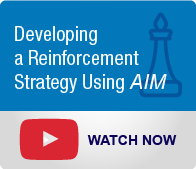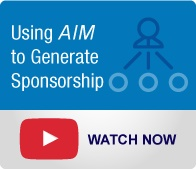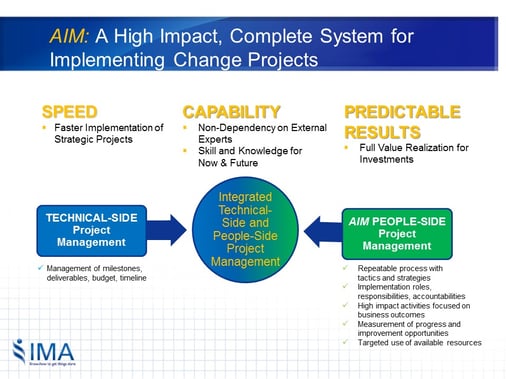Transforming your business may make strategic sense, but transformational change is complex. Enterprise-wide implementation of new systems, structures, and processes is time-consuming and incredibly challenging.  Mergers & Acquisitions, Re-structuring and Shared Services are all large-scale, highly disruptive changes that cannot be done incrementally. Once you take these leaps, you can’t change your mind and go back to the old ways.
Mergers & Acquisitions, Re-structuring and Shared Services are all large-scale, highly disruptive changes that cannot be done incrementally. Once you take these leaps, you can’t change your mind and go back to the old ways.
So, what does it take to succeed at transformational change? One of the biggest lessons we’ve learned during our 30+ years of Change Management Consulting experience, is not to waste your time and scarce resources on the things that will not transform your organization. Instead, take the time to ensure you have the following four fundamental requirements of a successful transformation.
What it Takes to Succeed: Four Fundamentals to Implementing Transformation
Fundamental #1: Understand the Difference between Installation vs. Implementation
To increase the likelihood of implementation success, organizations must adopt an “implementation mindset,” meaning there is a common vocabulary and framework for recognizing implementation success as measured by Project Return on Investment. The following 5 metrics should be used to define a “successful” project:
Ensuring the business and human objectives are met is the difference between installation and implementation. In other words, when you get to launch or go live, you haven't fully implemented true enterprise-wide change. Why? Because, there has been no sustained behavior change-- or what we call sustained adoption. No behavior change, no implementation. It’s a simple, but profound statement about the criticality of the human side of business projects, including transformational change initiatives.
Fundamental #2: Create a Clear, Compelling Definition of the Change
Right from the start of any transformational change, project teams must take a purposeful approach to identifying what the new behaviors are for the transformation. It’s why a foundation of IMA’s proprietary Accelerating Implementation Methodology (AIM) is, “In order to achieve value realization, you must first identify the “human objectives” for your change.” {Tweet This}
In order to properly define the change, you need to identify the behavior gap between the current state and the future state. In other words, what are people doing now and how should they behave after the change? In order to do so, there are four questions that need to be asked: 
- What is changing?
- Why you are changing?
- What are the consequences for not changing?
- How will success be measured?
These questions must be translated into the Frame of Reference for every work group impacted by the change. This means that the Definition of the Change (what we call the Business Case for Action) is a living, breathing document that is used, modified, and updated through the project lifecycle.
Fundamental #3: Put Radically Different Reinforcements in Place
Once you know what the new behaviors are that you are seeking, how do you then get people motivated to change and adopt these new ways of working? It’s not easy to get people to leave the comfort of the “status quo” and move to the unknown! 
It takes reinforcement, including positive rewards, negative consequences, and a plan for making the new ways of working easier than maintaining the status quo. Rewards are more powerful than negative consequences, but a mixture of both is needed. These rewards must also be in the Frame of Reference of the people who you want to change, and must be radically different from the present in order to drive transformation. The reinforcements must symbolize that “this change is different” and be tied directly to the transformation.
Remember, your organization is perfectly designed to get the behaviors you currently have!
Fundamental #4: Generate a Cascade of Committed Sponsors
Every manager with direct reports impacted by the change must Express, Model, and Reinforce their personal and collective commitment to the change. This level-by-level cascade of demonstrated Sponsorship is the  single most important factor in successful transformational change. Think of a waterfall that starts at the top and gains speed and force as it tumbles down to the river below. That's the power of cascading sponsorship!
single most important factor in successful transformational change. Think of a waterfall that starts at the top and gains speed and force as it tumbles down to the river below. That's the power of cascading sponsorship!
Remember though, transformation is typically an enterprise-wide change that spans multiple business organizations that currently operate as independent power structures. If each Sponsor believes his organization is “special and unique,” and requires a customized solution to what is supposed to be a unified change you will never achieve the full impact and cost benefits of business transformation. Getting Sponsors aligned across these silos is key to a successful transformation. 
Change is hard. Enterprise-wide, transformational change is geometrically more complex. But when you follow a repeatable change management methodology like the Accelerating Implementation Methodology (AIM), you can minimize business disruption while increasing the speed of implementation. AIM provides the structure needed to replicate the human change process across functions, geographies, power structures, and cultures. It is a complete system for implementing change projects. If your organization is currently going through a transformational change, are you on the right path to succeed?



